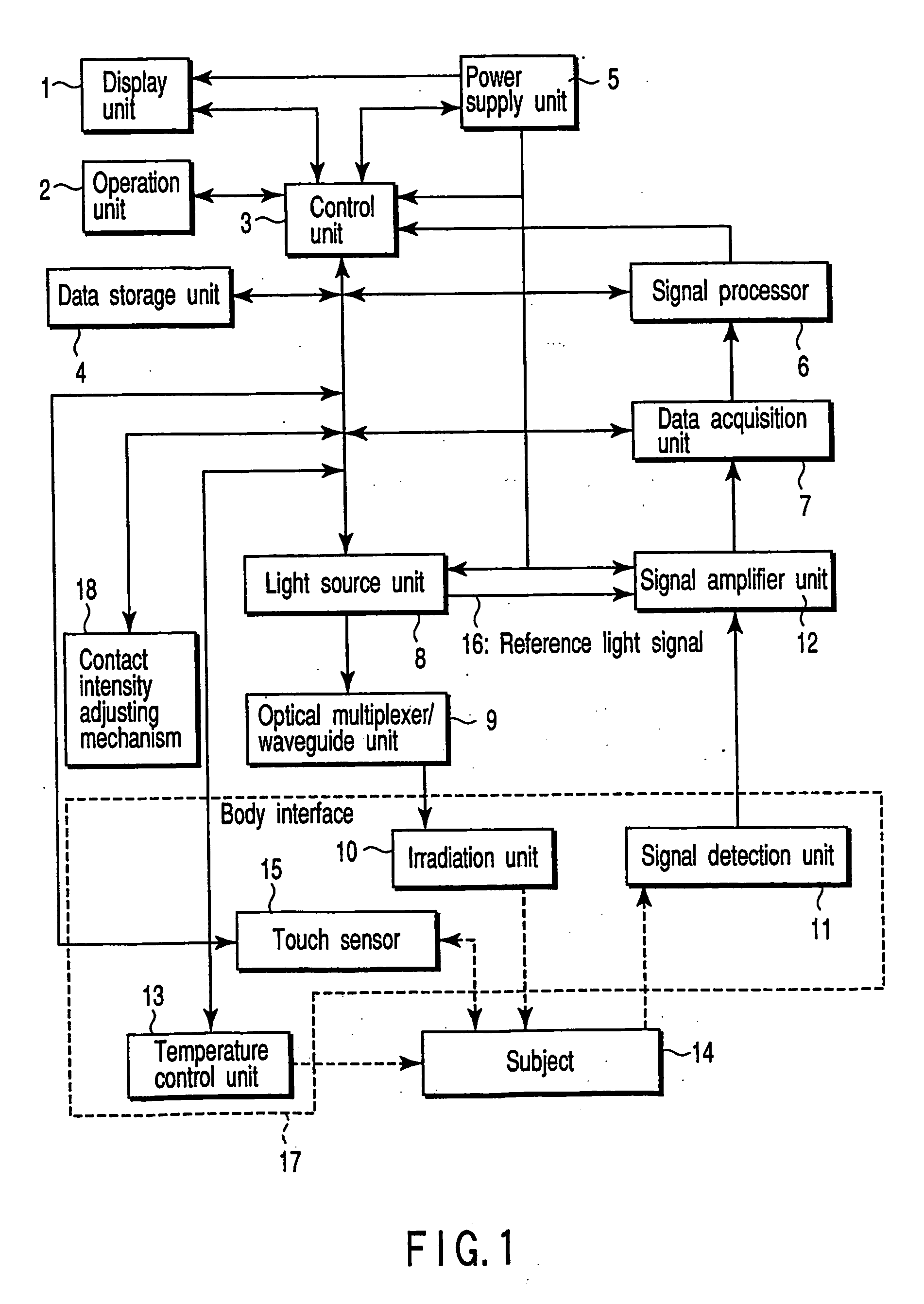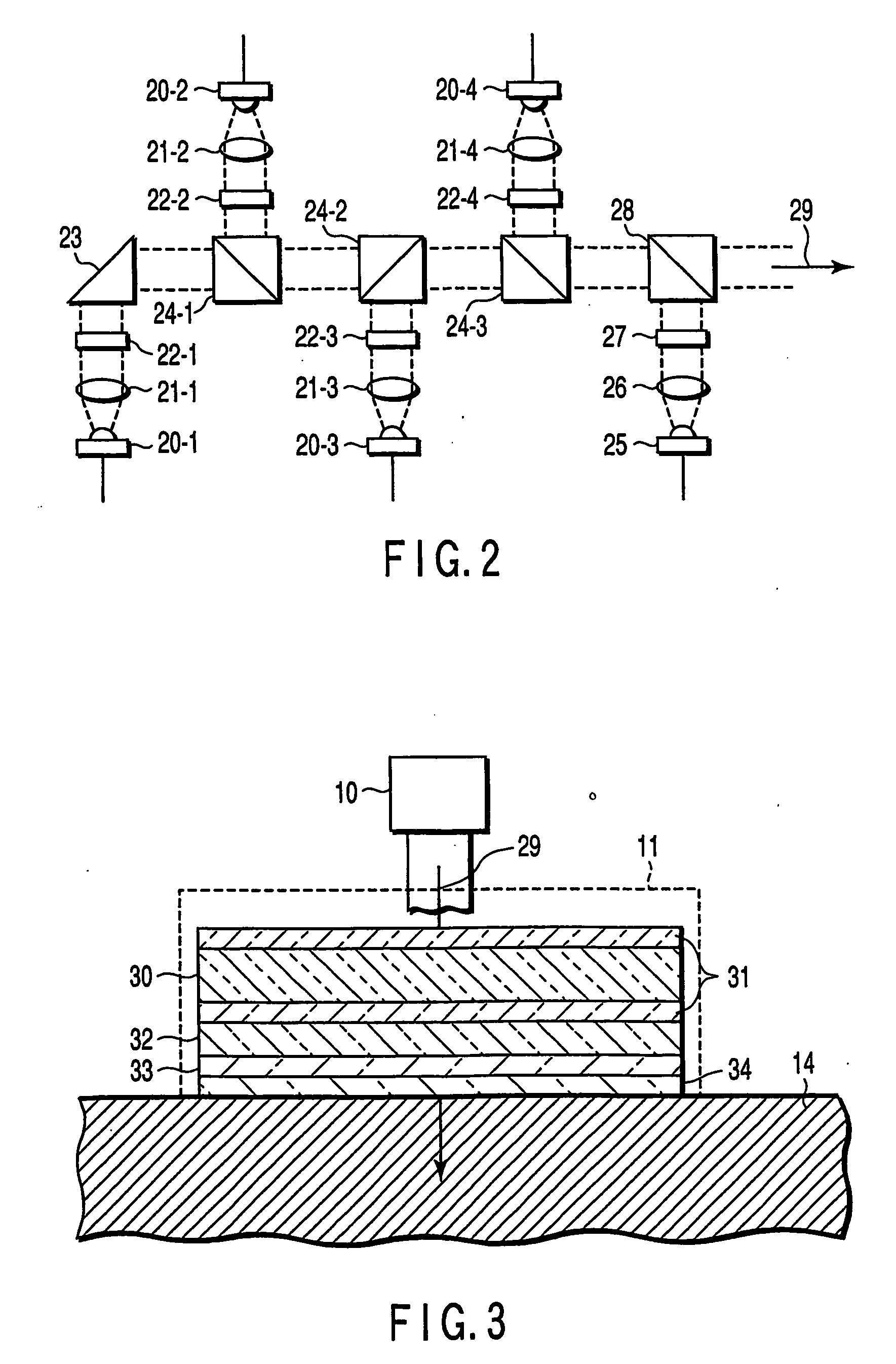Method and apparatus for non-invasive measurement of living body characteristics by photoacoustics
a non-invasive and living body technology, applied in the field of non-invasive measurement of living body characteristics by photoacoustics, can solve the problems of pain in the above-mentioned method, damage to the skin of the subject, and disadvantages of non-invasive spectroscopic monitoring using visible and/or near-infrared lights, and achieve the effect of high-precision measurement of a very faint acoustic signal
- Summary
- Abstract
- Description
- Claims
- Application Information
AI Technical Summary
Benefits of technology
Problems solved by technology
Method used
Image
Examples
first embodiment
[0033]FIG. 1 is a schematic diagram of an apparatus for non-invasive measurement of living body information, associated with the present invention. In FIG. 1, a light source unit 8 radiates one or more monochromatic light beams or light beams with a desired center wavelength and bandwidth. When there are two or more light beams radiated from the light source unit 8, they are multiplexed by an optical multiplexer / waveguide unit 9. Then, the light beams are guided to an irradiation unit 10 through the optical waveguide constituted as a part of the optical multiplexer / waveguide unit 9, such as an optical fiber, an optical thin film waveguide or free space, and the light is irradiated onto a measurement site of a subject 14 by the irradiation unit 10. Moreover, the light source unit 8 generates a reference light signal 16 which may be electric signal(s) and in proportion to the intensity of each monochromatic light or light with a desired center wavelength and bandwidth.
[0034] The acous...
second embodiment
[0046]FIG. 3 is a schematic diagram showing the structure of the apparatus for non-invasive measurement of a living body according to the present invention. The above-mentioned PZNT single crystal 30 is used for the photoacoustic signal detection unit 11. The PZNT single crystal 30 has high permeability in the wavelength range of visible light to near-infrared light, and the transmittance is typically about 70% in the wavelength range of 400-6000 nm. A transparent conductive material, which is used for the liquid crystal display and the plasma display, such as ITO (Indium Tin Oxide, In2O3(Sn)), is used as an electrode 31. The electrodes 31 are formed on both principal plane surfaces of the PZNT single crystal 30 by sputtering.
[0047] Furthermore, in order to make matching of the acoustic impedance with the subject 14, the acoustic matching layers 32 and 33 are formed on one of the electrodes 31. Epoxy resin, which is optically transparent can be used for the acoustic matching layers....
third embodiment
[0055]FIG. 6 is a schematic diagram showing the structure of the apparatus for non-invasive measurement of living body characteristics, associated with the invention. The light beams of two or more wavelengths emitted from the light sources 40-1, 40-2 and 40-3 are multiplexed on an optical axis by an optical multiplexer unit 41. The synthesized light is transmitted to an optical divider / switch unit 43 through an optical fiber 42 and is divided, branched, or demultiplexed by the optical divider / switch unit 43. The optical divider / switch unit 43 also controls whether the irradiation light beams are irradiated onto the subject 14 through the optical fiber 42 and light irradiation / photoacoustic signal detection unit 44.
[0056] The light irradiation / photoacoustic signal detection unit 44 has two or more illumination channels and / or signal detection channels in order to enable simultaneous measurement at two or more sites. The acoustic signals, emitted from the subject 14 by irradiating th...
PUM
 Login to View More
Login to View More Abstract
Description
Claims
Application Information
 Login to View More
Login to View More - R&D
- Intellectual Property
- Life Sciences
- Materials
- Tech Scout
- Unparalleled Data Quality
- Higher Quality Content
- 60% Fewer Hallucinations
Browse by: Latest US Patents, China's latest patents, Technical Efficacy Thesaurus, Application Domain, Technology Topic, Popular Technical Reports.
© 2025 PatSnap. All rights reserved.Legal|Privacy policy|Modern Slavery Act Transparency Statement|Sitemap|About US| Contact US: help@patsnap.com



